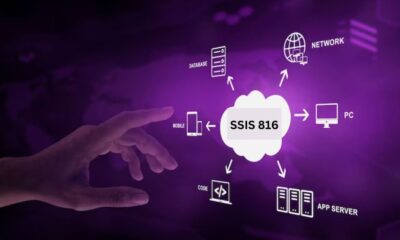Business
Unveiling Excellence: USC Business School Pioneering the Future of Business Education

Introduction:
History and Legacy
The USC Business School, established in 1920, holds a rich legacy of over a century in providing top-tier business education. Its roots delve deep into the history of USC, contributing significantly to the university’s esteemed reputation.
Academic Programs
-
Undergraduate Programs:
The undergraduate programs at USC’s Marshall School of Business offer a comprehensive curriculum, blending theoretical knowledge with practical applications. Students delve into diverse fields such as Finance, Marketing, Entrepreneurship, and more.
-
Graduate Programs:
USC Business School’s graduate programs are renowned globally. From the prestigious MBA program to specialized master’s degrees in fields like Finance, Business Analytics, and Entrepreneurship, the school caters to a wide spectrum of career aspirations.
3. Expert Faculty
At the heart of USC’s business education are its esteemed faculty members. Comprising industry experts, seasoned professionals, and thought leaders, they bring a wealth of experience into the classrooms, ensuring a dynamic and enriching learning environment.
Industry-Leading Expertise:
At USC Business School, a cadre of distinguished professors brings unparalleled expertise from diverse industries, enriching the academic experience with real-world insights.
Mentorship and Guidance:
Faculty members at USC actively engage with students, providing mentorship and guidance, fostering an environment of collaboration and continuous learning.
Innovation and Research
USC Business School prides itself on fostering a culture of innovation and research. Faculty and students engage in groundbreaking research, contributing valuable insights across various business domains, fostering innovation and contributing to global business knowledge.
Industry Connections and Partnerships
The school’s strategic location in Los Angeles provides unparalleled opportunities for students to connect with industry leaders and establish vital networks. USC’s robust partnerships with corporations and organizations offer internships, mentorship programs, and career opportunities for its students.
1. Strategic Collaborations with Corporate Giants:
USC Business School boasts strategic alliances with leading corporations across industries. These partnerships facilitate internships, guest lectures, and exclusive networking opportunities, providing students with invaluable exposure to real-world business dynamics. Collaborative projects and sponsored research initiatives further bridge academia and industry, fostering practical skill development and enriching educational experiences.
2. Entrepreneurial Ecosystem and Startup Collaborations:
The school actively engages with the entrepreneurial ecosystem, forging partnerships with startups, incubators, and accelerators. This collaboration offers students access to mentorship, funding opportunities, and hands-on experience in entrepreneurial endeavors. USC’s supportive environment nurtures innovation, encouraging students to turn ideas into viable ventures.
3. Alumni Engagement and Professional Networks:
USC Business School leverages its extensive alumni network to create robust professional connections. Alumni play an integral role by offering mentorship, internships, and career guidance to current students. Networking events, industry-specific forums, and alumni-driven initiatives foster a continuum of support, enhancing students’ career prospects and professional growth.
Entrepreneurship and Innovation
USC Business School nurtures an entrepreneurial spirit, empowering students to innovate and create. The Lloyd Greif Center for Entrepreneurial Studies fosters budding entrepreneurs, offering resources, mentorship, and programs to bring ideas to life.
Global Perspective and Diversity
Embracing diversity in all forms, USC Business School celebrates a global perspective. With a diverse student body and international programs, it ensures a broadened worldview essential for success in today’s interconnected business landscape.
1. Cultivating a Multifaceted Global Outlook:
USC Business School embraces diversity as a cornerstone of its educational philosophy. With a diverse student body representing various cultures, backgrounds, and perspectives, the school fosters an inclusive environment that encourages cross-cultural understanding and collaboration. Through global immersion programs, international partnerships, and a curriculum designed to embrace diverse viewpoints, USC instills in its students a global mindset essential for navigating the interconnected and multicultural landscape of modern business.
Alumni Success Stories
The school takes pride in its alumni network, which spans the globe and includes leaders in various industries. These alumni serve as inspirations, showcasing the impact of USC Business School’s education on successful careers and global contributions.
1. Global Impact and Leadership:
Highlighting Diverse Career Trajectories USC Business School alumni traverse diverse industries worldwide, holding leadership positions in Fortune 500 companies, spearheading entrepreneurial ventures, and influencing sectors ranging from technology and finance to healthcare and entertainment. Their global impact stands as a testament to the school’s comprehensive and impactful education.
2. Philanthropic Contributions and Community Engagement:
Beyond Professional Success Many USC Business School alumni contribute to society through philanthropy and community engagement. They establish foundations, initiate social impact projects, and actively participate in initiatives that drive positive change, reflecting the school’s ethos of holistic leadership.
3. Alumni Network and Continued Collaboration:
Building a Strong Network of Support The tight-knit USC Business School alumni community fosters continued collaboration. Through networking events, mentorship programs, and resource sharing, alumni create a robust support system, facilitating career growth and ongoing learning opportunities for current and future graduates.
Conclusion:
USC Business School, with its rich heritage, commitment to innovation, and a holistic approach to education, continues to set benchmarks in the realm of business education. It stands as a beacon of excellence, shaping the future of business leaders worldwide.
Business
Exploring the Stellar Cast of Prison Break
Business
Understanding the Importance of an IOC (Indicator of Compromise)

Introduction
In today’s digitally connected world, cybersecurity stands as a paramount concern for individuals, businesses, and organizations alike. Among the many tools and concepts employed to bolster cybersecurity, the Indicator of Compromise (IOC) emerges as a crucial element. Understanding what an IOC is and its significance is pivotal in safeguarding digital assets and preventing potential cyber threats.
What is an IOC?
An Indicator of Compromise (IOC) refers to any evidence or abnormality observed in a system or network that potentially indicates a cybersecurity breach or an ongoing threat. These indicators vary in nature, ranging from file hashes, IP addresses, suspicious network traffic, to unusual system behavior or unauthorized login attempts.
Types of IOCs
- Hash-based IOCs: These involve unique identifiers generated using algorithms like MD5, SHA-1, or SHA-256, representing a specific file or piece of malware.
- File-based IOCs: Signature-based indicators identifying specific files or components known to be malicious.
- Behavioral IOCs: Abnormalities in system behavior, such as unexpected network traffic patterns or unauthorized access attempts.
- Artifact-based IOCs: Information left behind by attackers during an intrusion, such as logs or system changes.
Importance of IOC in Cybersecurity
Early Detection
One of the primary advantages of utilizing IOCs is their role in early threat detection. By identifying these indicators promptly, security teams can respond swiftly, mitigating potential damage or data breaches before they escalate.
Incident Response and Forensics
IOCs serve as vital breadcrumbs during incident response and forensic analysis. They aid in tracing the origin and scope of an attack, allowing organizations to understand the attack methodology and fortify defenses against similar threats in the future.
Proactive Defense
Employing IOCs enables organizations to adopt a proactive approach to cybersecurity. Continuously monitoring and updating IOCs bolsters security measures, preventing known threats and vulnerabilities from exploiting systems.
Creating and Utilizing IOCs
Collection and Aggregation
Security professionals gather IOCs from various sources, including threat intelligence feeds, security advisories, malware analysis reports, and internal monitoring tools. These indicators are then aggregated and categorized for easier analysis and implementation.
IOC Implementation
Continuous Updating
Cyber threats evolve rapidly, rendering older IOCs obsolete. Regular updates and continuous monitoring are crucial to maintaining an effective IOC strategy. Security teams must stay vigilant, ensuring that the IOCs are updated to detect emerging threats.
Challenges and Limitations
False Positives
One of the challenges with IOCs is the potential for false positives, where legitimate activities or benign elements trigger alarms, leading to unnecessary investigations or disruptions.
Evolving Threat Landscape
Cyber threats continuously evolve, employing sophisticated techniques to bypass traditional security measures. Keeping up with these changes and updating IOCs accordingly is a perpetual challenge.
Lack of Standardization
The absence of standardized IOC formats and protocols can hinder interoperability between different security systems and tools, complicating the sharing and utilization of IOCs across platforms.
Conclusion
In conclusion, the Indicator of Compromise (IOC) serves as a cornerstone in modern cybersecurity practices. Its role in early threat detection, incident response, and proactive defense is indispensable. However, to harness its full potential, organizations must address challenges such as false positives, evolving threats, and standardization issues.
FAQS:
Business
Mastering the Art of Denim Stacking: Elevate Your Style Game

Introduction
Denim stacking has emerged as a prominent fashion trend, revolutionizing the way we wear jeans. This technique involves the intentional stacking or bunching of denim fabric around the ankles, creating a stylish and personalized look. As a fashion enthusiast, understanding the nuances of denim stacking can help you elevate your style quotient effortlessly.
What is Denim Stacking?
Denim stacking refers to the intentional gathering or bunching of excess fabric around the ankles of jeans. This technique involves allowing the fabric to naturally fold or bunch, creating a stacked effect. It’s a styling method that adds depth and dimension to your outfit, offering a relaxed yet trendy appearance.
The Art of Achieving Perfect Denim Stacks
-
Choosing the Right Jeans
-
Ideal Length for Stacking
-
Understanding Fabric Weight
Techniques for Denim Stacking
-
Single Cuff Method
-
Double or Triple Cuff
-
Natural Stacking
Styling Tips with Denim Stacking
-
Footwear Pairings
-
Top Wear Choices
-
Accessorizing
Maintenance and Care
-
Preserving the Stacks
-
Ironing and Steaming
Conclusion
Denim stacking is a versatile and trendy way to personalize your denim style. Mastering this art allows you to experiment with various looks while adding a touch of individuality to your outfits. By understanding the techniques and nuances of denim stacking, you can effortlessly elevate your fashion game and stand out with a unique, relaxed yet stylish appearance.
FAQS:
1. What is denim stacking, and how do I achieve the perfect look?
Denim stacking is a stylish technique where excess fabric around the ankles of jeans is intentionally gathered or bunched, creating a stacked effect. To achieve the perfect look, opt for slim or tapered jeans with a slightly longer length and experiment with folding techniques like single or multiple cuffs.
2. Can any type of jeans be used for denim stacking?
While any type of jeans can be used, slim or tapered jeans with a bit of stretch tend to work best for denim stacking. Lighter denim fabrics are also preferable as they naturally lend themselves to creating effortless and pronounced stacks.
3. How do I maintain and care for stacked denim?
To preserve the stacks, avoid excessive washing. If washing is necessary, turn the jeans inside out and use cold water. Additionally, use a steamer or iron on a low setting to smoothen out any unwanted creases without compromising the stacked effect.
-

 Technology7 months ago
Technology7 months agoKooraLive English: Guide to Live Sports Streaming
-

 Technology7 months ago
Technology7 months agoSSIS 816 Revolutionizing Data Integration
-

 Health7 months ago
Health7 months agoOptimizing Health: The Comprehensive Guide to TG Tubes
-

 Lifestyle5 months ago
Lifestyle5 months agothe Charm of Villages: Decoding the Loofa Code
-

 Entertainment6 months ago
Entertainment6 months agothe Mystery: packgod face reveal
-

 Business4 months ago
Business4 months agoSimplifying Work Life: NetchexOnline Employee Login
-

 Technology7 months ago
Technology7 months agoThe Power of Innocams
-

 Technology7 months ago
Technology7 months agoPotential of Pixwox: Your Guide to Superior Visual Content

